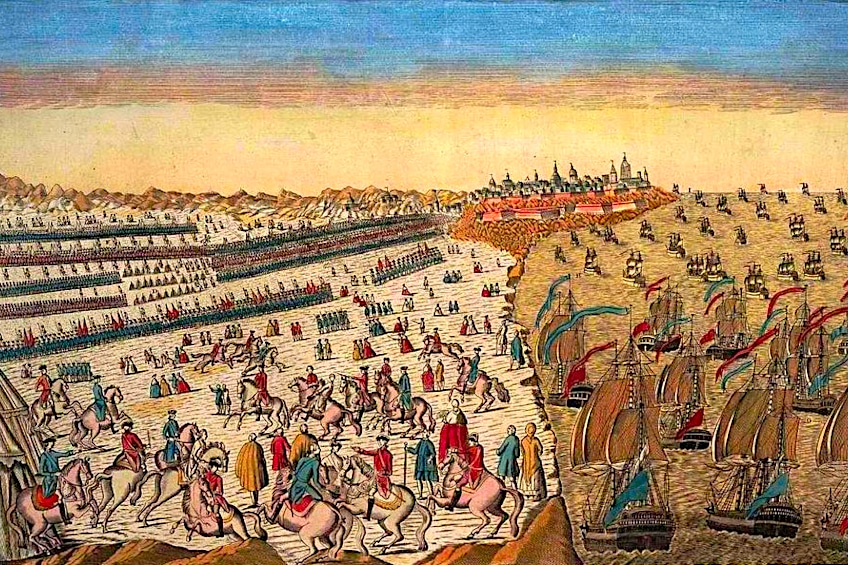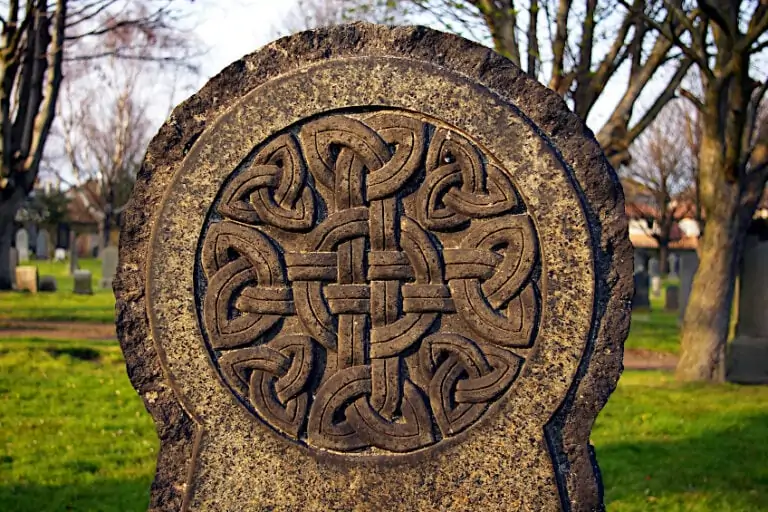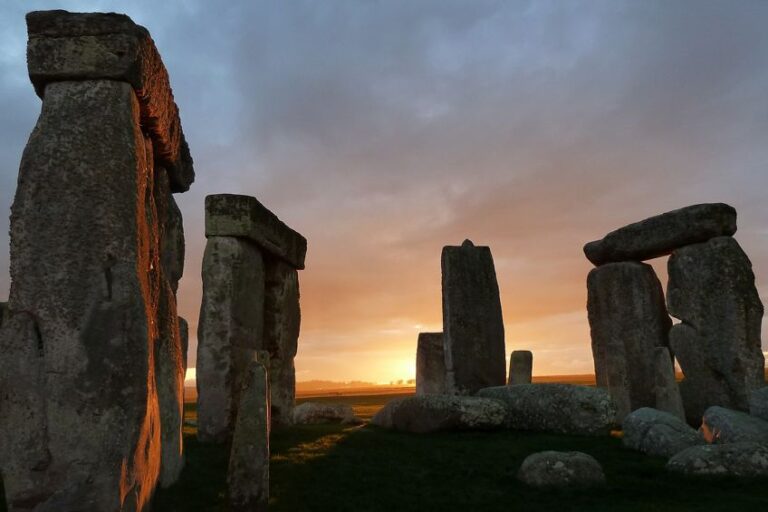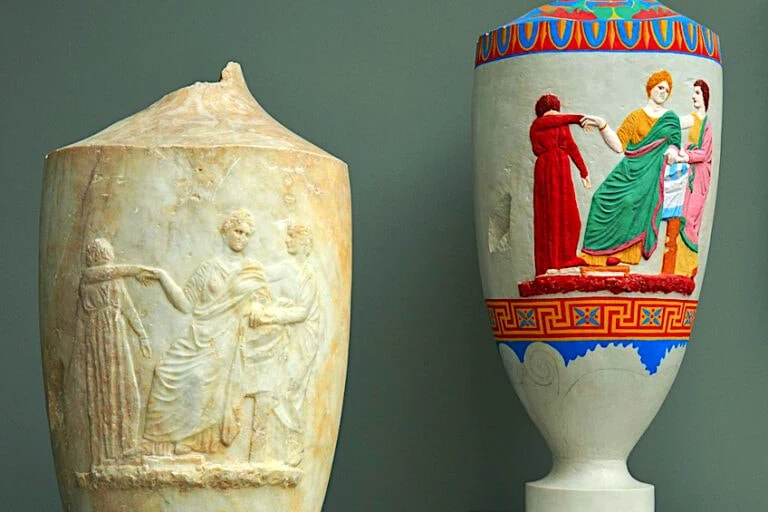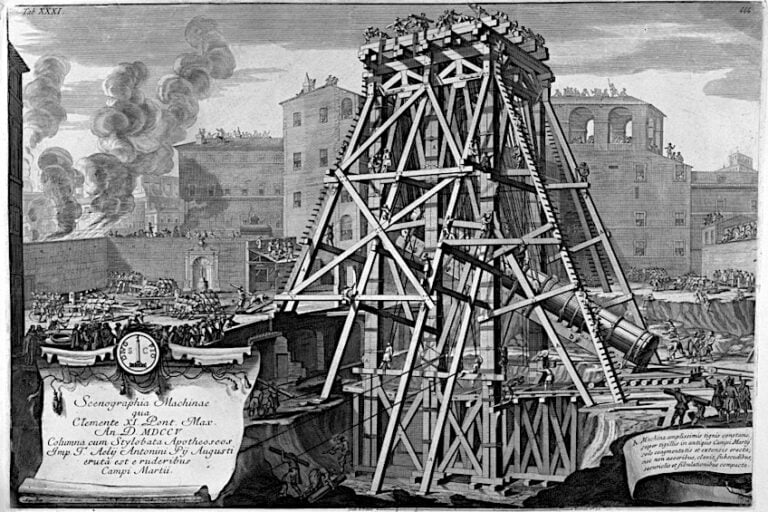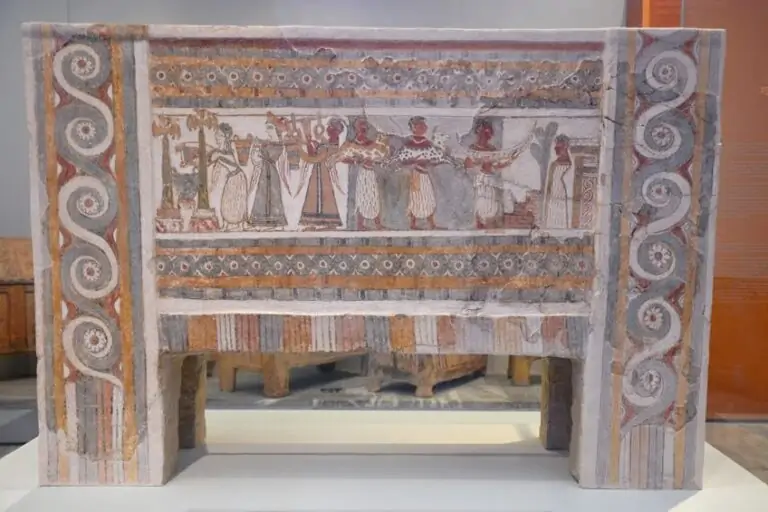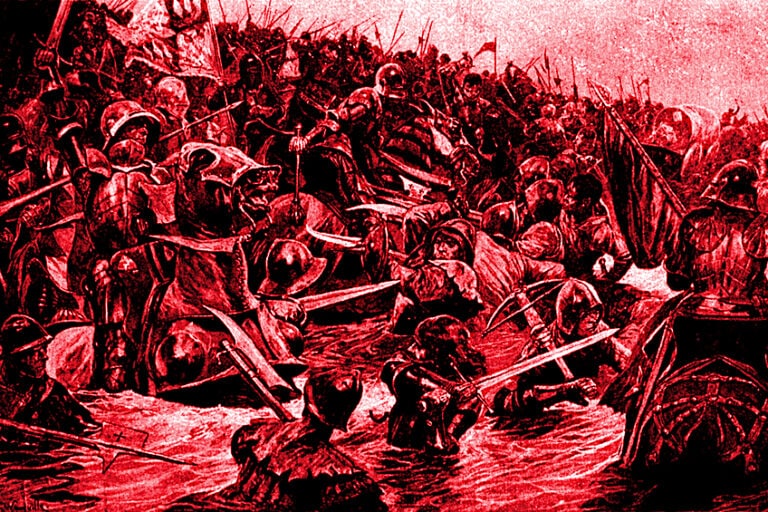Battle of Yorktown – A Pivotal Point in the American Revolution
The Battle of Yorktown is regarded as a pivotal moment in the American Revolutionary War. But, why did the Battle of Yorktown happen and who won the Battle of Yorktown? In this article, we will explore all the facts about the Battle of Yorktown, and provide context to this significant moment that effectively ended the American Revolution. Join us as we learn how many casualties were in the Battle of Yorktown, and answer your questions related to the topic, such as “when was the Battle of Yorktown?”.
Contents
The Historical Context of the Battle of Yorktown
| Name of Battle | Battle of Yorktown |
| War Associated With | American Revolutionary War |
| Date Battle Began | 28 September 1781 |
| Date Battle Ended | 19 October 1781 |
| Location of Battle | Yorktown, Virginia, United States |
Both the Continental and British troops were worn out following six years of constant war. In what was considered very hostile territory, the British controlled just a few coastal locations throughout America. Britain at that time was also engaged in a war with Spain and France. The conflict in America was controversial and unpopular, and there was no clear end in sight. The protracted war for independence was causing massive debt, and a shortage of food supplies, and the troops lacked morale in the colonies. Both sides of the battle were eager for a decisive outcome.
In the spring of 1781, General George Washington and his Continental Army faced a critical dilemma. They had the option of striking a significant blow against the British troops positioned in New York City or heading south to Yorktown, where General Charles Lord Cornwallis’ men were stationed.
 Washington Before Yorktown by Rembrandt Peale (1823); Rembrandt Peale, Public domain, via Wikimedia Commons
Washington Before Yorktown by Rembrandt Peale (1823); Rembrandt Peale, Public domain, via Wikimedia Commons
General Washington and Lt. Gen. Comte de Rochambeau, his French ally, banked on the south, where a French navy led by Adm. Comte de Grasse would provide essential naval support. The troops of Allied forces advanced hundreds of miles from their New York City headquarters to Yorktown, constituting the American Revolution’s biggest mobilization of troops. The British were not expecting the battle that ultimately shifted the course of the American Revolutionary War.
Why Did the Battle of Yorktown Happen?
Before we get into the battle itself, it is important to understand what motivated both sides of the conflict. The major goal for both sides in this conflict was to seize possession of Yorktown in Virginia, one of the York River’s key ports. As part of their attempt to preserve control of the colonies, the British troops had set up a bastion in Yorktown. They possessed well-trained soldiers and a fleet of ships, which they believed would give them the other upper hand in keeping control of the region.
The British estimated that retaining control of Yorktown would enable them to maintain control of the surrounding territories too.
General George Washington commanded the American troops in their determination to take down the British invaders and win their hard-fought independence. They had been fighting the English for a long time, and this battle provided them with the opportunity for an essential victory that would greatly shift the direction of the war. The American troops received aid from the French, who supplied naval and military support to the American soldiers. The French were also driven by a desire to destabilize Britain, their main adversary in Europe.
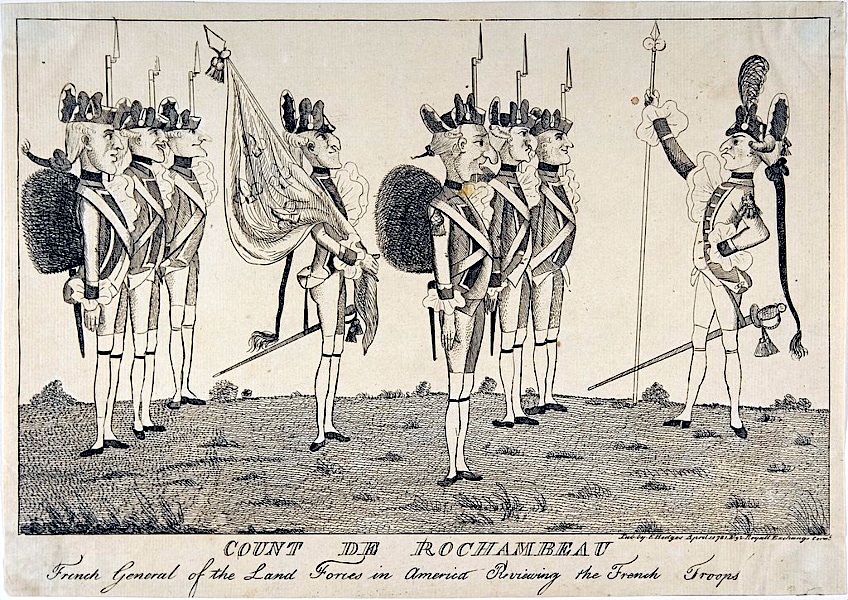 British caricature depicting Count de Rochambeau, French General of the Land Forces in America Reviewing the French Troops by E. Hedges (1781); Metropolitan Museum of Art, CC0, via Wikimedia Commons
British caricature depicting Count de Rochambeau, French General of the Land Forces in America Reviewing the French Troops by E. Hedges (1781); Metropolitan Museum of Art, CC0, via Wikimedia Commons
Causes of the Battle of Yorktown
The Battle of Yorktown would prove to be a pivotal and significant moment in the Revolutionary War, and both sides had substantial motivation for taking possession of Yorktown. But, why was this battle necessary in the first place? What were the various political, economic, and ideological factors that caused the revolution which culminated in this battle?
Political Factors
The political causes that influenced the Battle of Yorktown sprang from long-standing conflicts between the British authorities and American colonists. They had long demanded greater participation in the British administration, claiming that they were being taxed unfairly. However, the British were hesitant to provide these rights to the Americans and continued to levy severe taxes on them.
The British government’s actions fanned revolutionary feelings among the American colonists, who started organizing and mobilizing against British authority in response. To oppose British policies and coordinate demonstrations and boycotts, the Americans formed various committees.
Economic Factors
The economic issues that influenced the Battle of Yorktown were inextricably linked to political factors. The colonists thought that the British government was treating them unjustly and that British policies were limiting their economic potential. The British authorities enforced a number of economic measures that seriously affected the economy of America.
These regulations included trade restrictions, hefty taxes on American goods, and a ban on American colonists producing specific commodities.
The British government’s economic policies caused a substantial decline in the economy, which was primarily reliant on commerce. The colonists’ ability to continue their livelihoods became increasingly difficult as they were obliged to pay exorbitant taxes to the British, which further exacerbated their hatred towards the English and desire for independence.
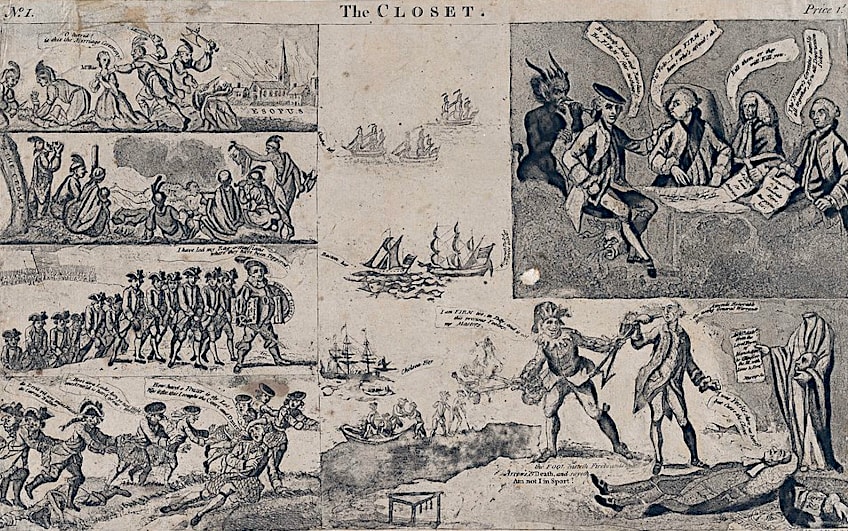 Cartoon depicting the contributing factors to the American Revolution by an unknown artist (1778). The imagery suggests that a combination of tyranny, military failures, and atrocities resulted from the malign influence of John Stuart, the Earl of Bute, Lord Mansfield, and Lord Germain on George III; Metropolitan Museum of Art, CC0, via Wikimedia Commons
Cartoon depicting the contributing factors to the American Revolution by an unknown artist (1778). The imagery suggests that a combination of tyranny, military failures, and atrocities resulted from the malign influence of John Stuart, the Earl of Bute, Lord Mansfield, and Lord Germain on George III; Metropolitan Museum of Art, CC0, via Wikimedia Commons
Ideological Factors
In contrast to the autocratic and hierarchical British authorities, many colonists in America believed in the concepts of individual liberty, democracy, and limited government. The colonists thought that they had the right to self-governance and did not need to be subject to the control of a remote and indifferent government. Enlightenment values, which stressed the importance of logic, knowledge, and personal liberty, also affected the colonists.
These views were expressed in the literature of famous authors like Thomas Paine and John Locke, who claimed that everyone had the right to liberty and property and that institutions should be founded to preserve these rights.
The British, though, believed in an authoritarian administration in which power was centralized in the hands of the nobility and royalty. The British felt they had the authority to control the colonies and impose their rules and regulations on them irrespective of the colonist’s personal wants or opinions. These ideological conflicts between the Americans and the British government contributed significantly to the colonists’ revolutionary desires. The colonists felt they were fighting for their individual rights, but the British government saw them as disobedient subjects who needed to be subdued.
Facts About the Battle of Yorktown
Now that we know the background context of what led up to this conflict, we can look at the battle itself. The British initially took Yorktown in the autumn of 1781, intending to replenish Cornwallis’ 9,000 soldiers. The colonists seized the opportunity as Cornwallis awaited provisions from the Royal Navy.
Before the Battle of Yorktown
When Washington and Rochambeau heard that the French navy was ready for a siege south of New Jersey, they sent their army of over 8,000 soldiers south to Virginia, with the goal of joining and leading roughly 12,000 additional soldiers comprising of French, colonial, and militia soldiers in a siege of Yorktown. While the Allied forces were still on their way, the French guarded the entrance to Chesapeake Bay on the 5th of September.
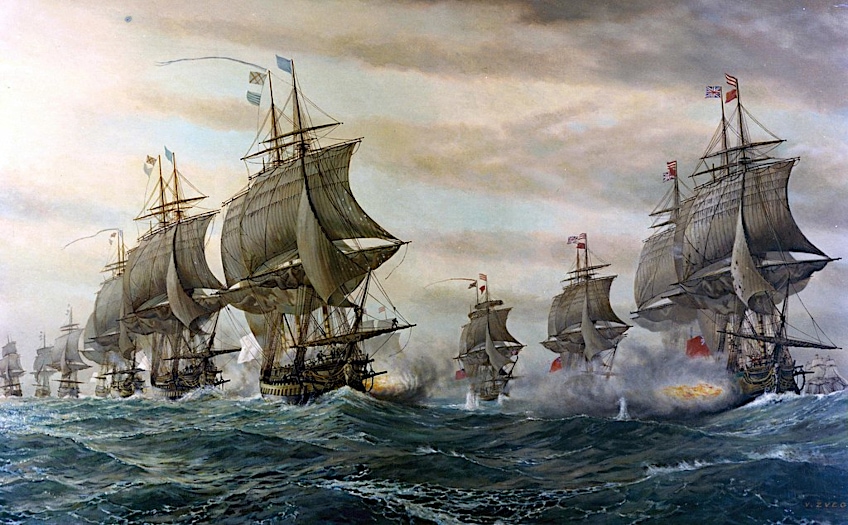 Battle of the Virginia Capes, 5 September 1781 by V. Zveg (1962); National Museum of the U.S. Navy, Public domain, via Wikimedia Commons
Battle of the Virginia Capes, 5 September 1781 by V. Zveg (1962); National Museum of the U.S. Navy, Public domain, via Wikimedia Commons
While attempting to sail up the Bay to Cornwallis, the Royal Navy was intercepted at the mouth of the Chesapeake by French ships. The British were brutally destroyed in this battle, known as the Battle of the Capes, and were forced to leave Cornwallis’ forces unaided at Yorktown.
During the Battle of Yorktown
The French and American colonial forces finally arrived near Yorktown on the 28th of September after a laborious march and instantly set about the difficult task of laying siege to Cornwallis’ men. He had constructed a number of redoubts on the outer edges of Yorktown, while the majority of his troops remained in the town. By the 9th of October, the Allied troops had reached within musket range of the opposition. Washington initiated the battle by setting off a cannon.
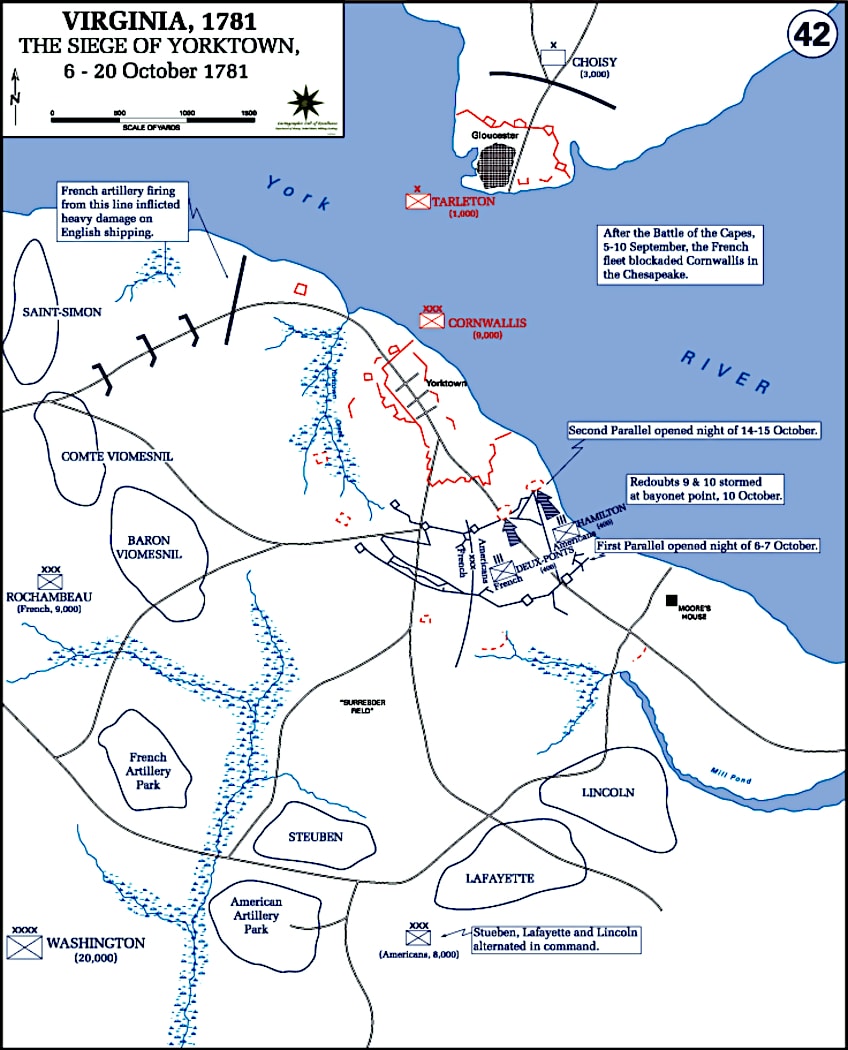 Battle tactics at the Battle of Yorktown; U. S. Military Academy, Public domain, via Wikimedia Commons
Battle tactics at the Battle of Yorktown; U. S. Military Academy, Public domain, via Wikimedia Commons
The artillery onslaught went on for over a week, destroying whatever nerve the British troops had left and creating massive gaps in their defenses.
On the 14th of October, after firing ceaseless artillery to break down British fortifications, Colonial and French soldiers staged a surprise assault. They did not even prime their guns in order to remain stealthy. The assault began at 6:30 p.m. with a diversionary attack farther north of Yorktown, giving the impression that the town itself was to be attacked. Then, with bayonets set and muskets unloaded, Lt. Col. Alexander Hamilton’s men attacked one of the redoubts. Lt. Col. John Laurens’ men guarded the back of the redoubt to prevent the British from fleeing the approaching attack. Cornwallis ordered a counterattack on the 15th of October, which was completely unsuccessful.
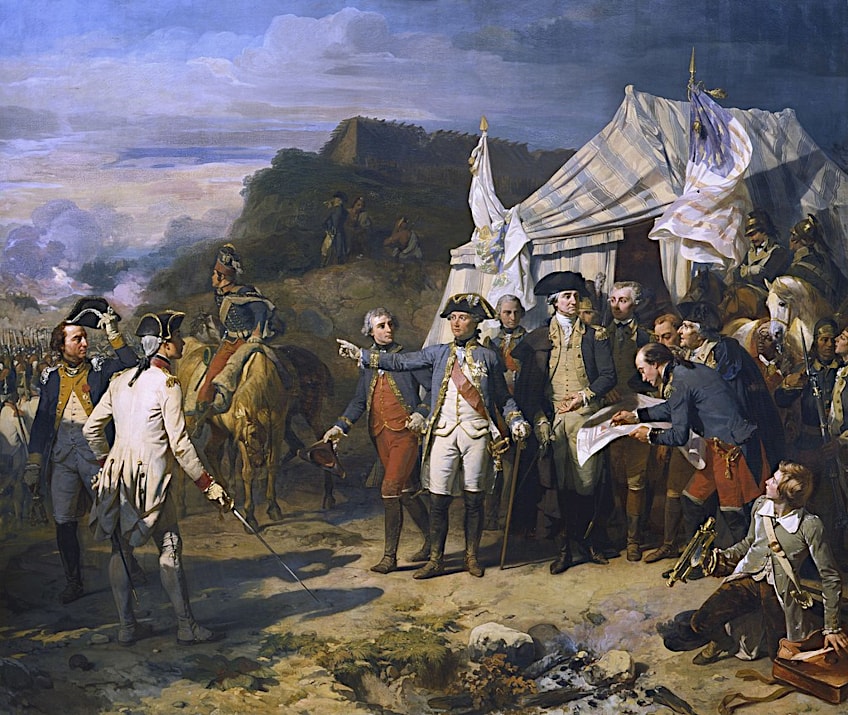 Siege of Yorktown by Auguste Couder (1836); Auguste Couder, Public domain, via Wikimedia Commons
Siege of Yorktown by Auguste Couder (1836); Auguste Couder, Public domain, via Wikimedia Commons
On the 17th of October, just a single British drummer boy and one British commander waving a white handkerchief could be seen atop a parapet at the front lines of the British occupancy.
The British officer, blindfolded and carried within American lines, arranged conditions of capitulation for the British Army. On the 19th of October, British soldiers and their allies marched sullenly between units of French and American forces in a field outside of Yorktown as the capitulation took place. The British requested honorable conditions of surrender, however, Washington refused since American men were denied the same honor earlier in the conflict in Charleston.
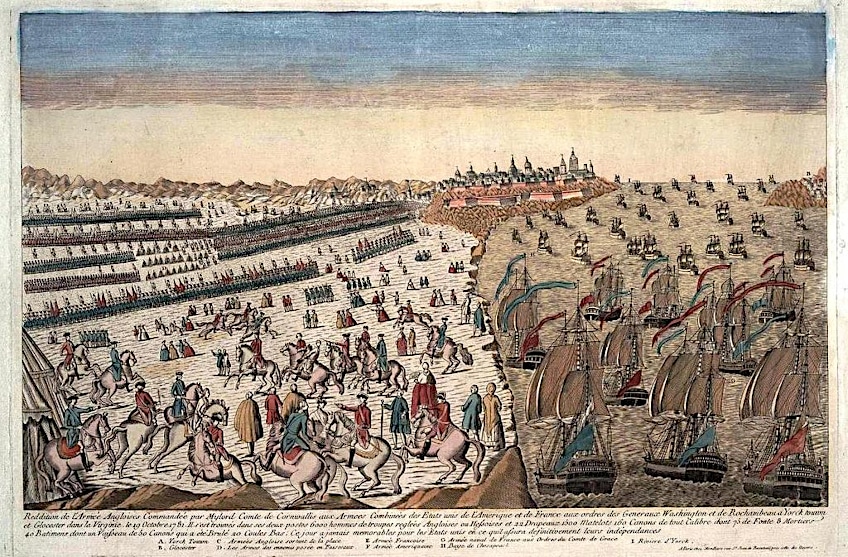 Depiction of the surrender of the British army to the combined armies of the United States of America and France at Yorktown and Gloucester on October 19, 1781; Artiste inconnu, Public domain, via Wikimedia Commons
Depiction of the surrender of the British army to the combined armies of the United States of America and France at Yorktown and Gloucester on October 19, 1781; Artiste inconnu, Public domain, via Wikimedia Commons
The Aftermath
Following the capitulation, the colonial and French commanders hosted a dinner for the British officers. The British officers were said to be “overwhelmed” by the kindness shown to them by their former adversaries, with several French officers giving “profuse” apologies for the defeat, according to Captain Samuel Graham, a British officer. Cromot du Bourg, Rochambeau’s French assistant, also remarked on the British commanders’ composure, notably O’Hara, in light of their defeat.
 George Washington Accepting Lord Cornwallis’s Sword by Alice Spaulding Hemenway (19th Century); Alice Spaulding Hemenway, Public domain, via Wikimedia Commons
George Washington Accepting Lord Cornwallis’s Sword by Alice Spaulding Hemenway (19th Century); Alice Spaulding Hemenway, Public domain, via Wikimedia Commons
On the 24th of October, 1781, five days after the conflict, the British navy dispatched by Clinton to retrieve the British forces arrived. On the 18th of October 18, the navy picked up a group of provincials who had managed to escape and notified Admiral Thomas Graves that Cornwallis had surrendered. Graves picked up a few more provincials down the shore, who verified this.
He saw the French Fleet but opted to depart since he was overwhelmingly outnumbered by nine warships, therefore, he returned the fleet to New York. On the 25th of October, Washington issued a directive for any fugitive slaves who had joined the British to be picked up and placed under the control of armed guards in armed locations on both banks of the York River. They were intended to stay there until arrangements could be made to have them returned to their owners.
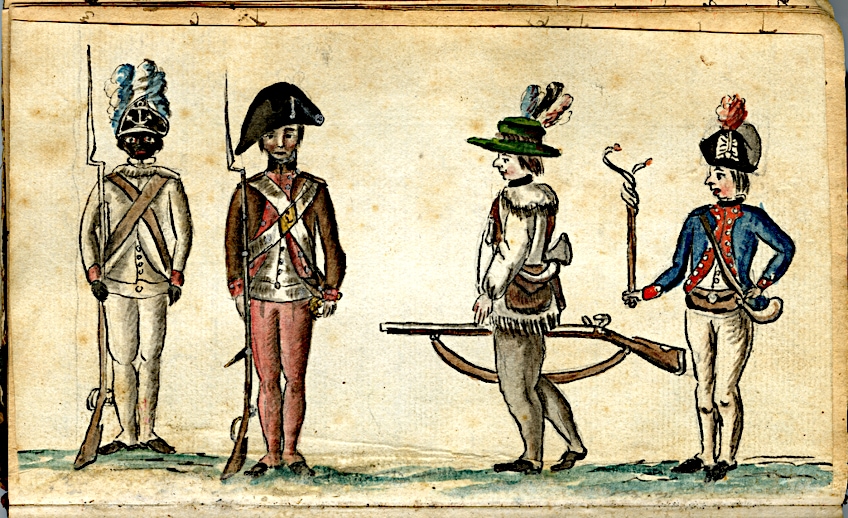 American Soldiers at the siege of Yorktown by Jean-Baptiste-Antoine DeVerger (1781); Jean-Baptiste-Antoine DeVerger, Public domain, via Wikimedia Commons
American Soldiers at the siege of Yorktown by Jean-Baptiste-Antoine DeVerger (1781); Jean-Baptiste-Antoine DeVerger, Public domain, via Wikimedia Commons
Historians describe Washington’s actions as turning his faithful colonials – the people who won America’s independence – into a regiment of slave hunters. Following the British capitulation, Washington dispatched Tench Tilghman to inform Congress of the victory.
After a long voyage, he arrived in Philadelphia, where celebrations took place for many days. When informed of the loss, Lord North, the British Prime Minister is said to have cried, “Dear God, it is all over!”. Three months after the conflict, the British House of Commons voted a motion to stop “the further pursuit of offensive warfare in North America”, essentially a motion of no-confidence. Lord North and his administration subsequently stepped down. Washington relocated his troops to New Windsor in New York, where they stayed until the 13th of September, 1783, when the Treaty of Paris was signed, thereby ending the war.
The campaign in Yorktown had proven to be crucial; there would be no major conflict on the North American mainland following the Battle of Yorktown.
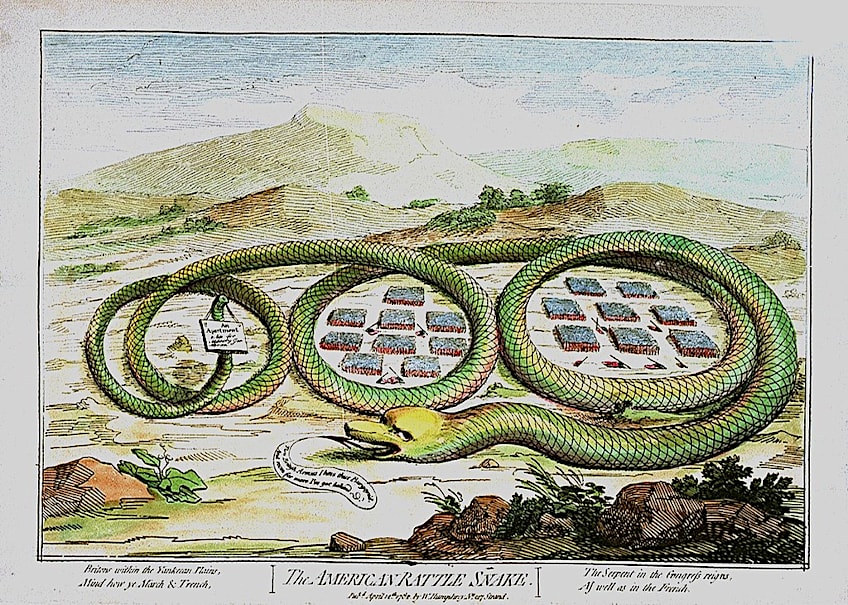 The American Rattlesnake by James Gillray (1782) depicts the rattlesnake used by the American revolutionaries on their flag surrounding surrendered British soldiers following the Battle of Yorktown; Humphrey, W [publisher], Public domain, via Wikimedia Commons
The American Rattlesnake by James Gillray (1782) depicts the rattlesnake used by the American revolutionaries on their flag surrounding surrendered British soldiers following the Battle of Yorktown; Humphrey, W [publisher], Public domain, via Wikimedia Commons
How Many Casualties Were in the Battle of Yorktown?
The British war efforts in America ceased after this pivotal battle, and if one looks at the casualty numbers, it’s not too hard to see why. Overall, there were approximately 9,000 casualties in the battle. A recorded 88 Americans were killed in the conflict, and 142 British soldiers lost their lives. There were a further 301 wounded Americans recorded in addition to the 326 wounded British soldiers. The biggest difference in numbers can be seen in the “missing and captured” category, though.
While there were no American soldiers recorded as captured or missing, there were just over 7,410 British soldiers recorded as either captured or missing following the Battle of Yorktown.
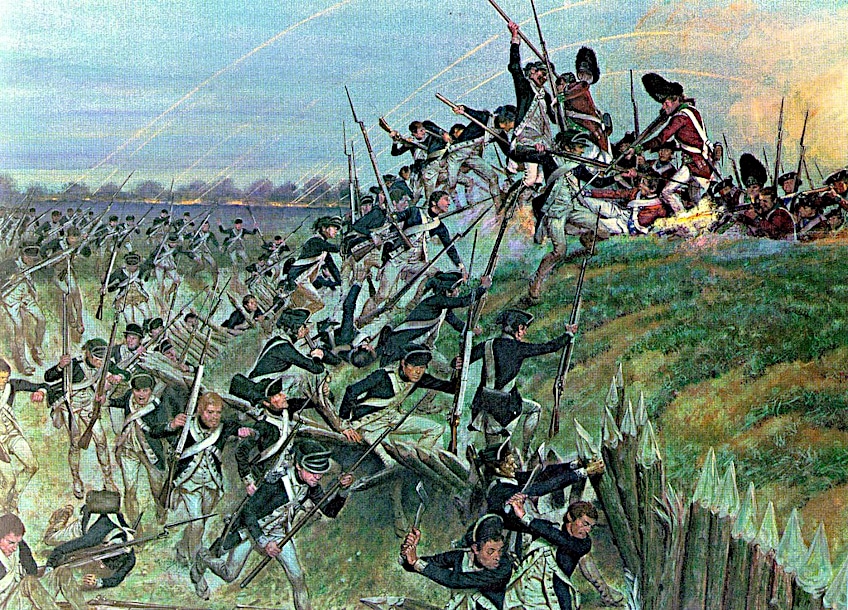 Depiction of the American assault on Redoubt 10 at Yorktown; U. S. Army Center of Mlitary History, Public domain, via Wikimedia Commons
Depiction of the American assault on Redoubt 10 at Yorktown; U. S. Army Center of Mlitary History, Public domain, via Wikimedia Commons
Consequences for Both Sides of the Battle of Yorktown
As we have learned, the battle proved to be a very pivotal moment in the American Revolutionary War. Following the battle, both sides experienced immediate consequences – positive for some, and negative for others. Let’s recap the most essential consequences for both sides of the conflict.
Consequences for the American Colonials
The victory at Yorktown was a watershed moment in the Revolutionary War, providing a significant morale boost to the American soldiers. It aided in garnering support and acknowledgment from other countries, notably France, which was critical to the colonial’s victory. The British army’s loss at Yorktown resulted in the Treaty of Paris in 1783, which acknowledged North America as an independent nation.
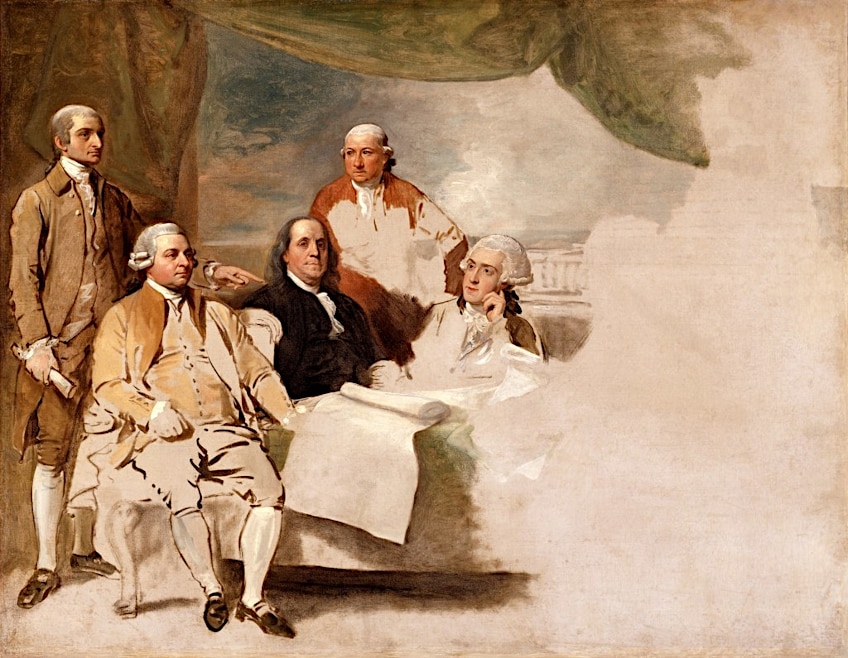 American Commissioners of the Preliminary Peace Agreement with Great Britain (unfinished oil sketch) by Benjamin West (between 1783 and 1784); Benjamin West, Public domain, via Wikimedia Commons
American Commissioners of the Preliminary Peace Agreement with Great Britain (unfinished oil sketch) by Benjamin West (between 1783 and 1784); Benjamin West, Public domain, via Wikimedia Commons
Consequences for the British Government
The defeat dealt a severe setback to the British army, essentially ending their aspirations to govern the southern colonies. The war’s financial toll was also felt by Britain, which faced rising debt issues as a result of the protracted war. The defeat at Yorktown also resulted in political upheavals in the United Kingdom, notably the demise of Prime Minister Lord North’s ministry and a turn toward reconciliation with the American colonials.
Consequences for Long-Term American/British Relations
The relationship between the two nations was tense after the Revolutionary War ended, but steadily improved over time. The agreement officially acknowledged the United States’ independence, but it did not resolve concerns like commerce, debts, or compensation for loyalists who had helped the British throughout the revolutionary war. Initially, there was significant animosity and anger on both sides, with people either believing that the pact was either too liberal or too lenient. Yet, through diplomatic efforts and economic agreements, the two countries gradually began to repair their ties.
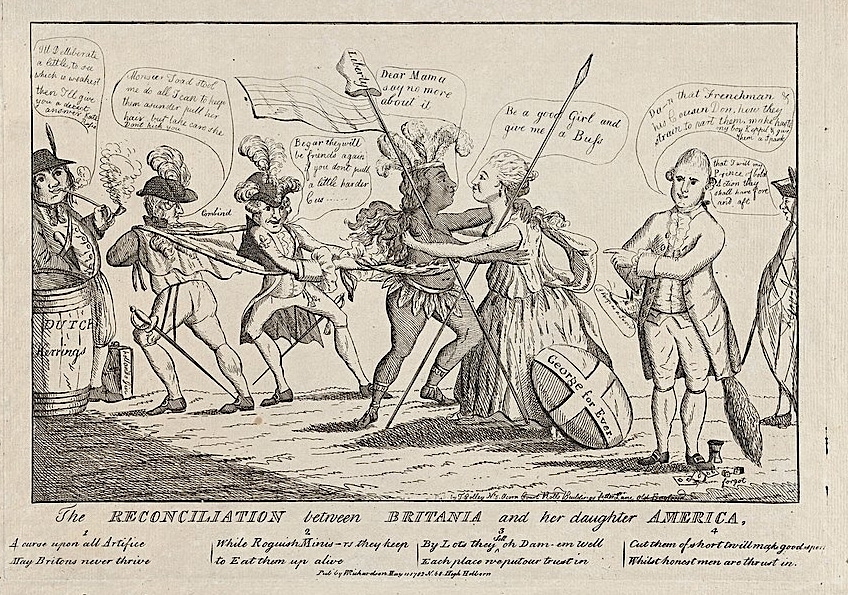 The Reconciliation Between Britannia and Her Daughter America by Thomas Colley (1782); William Richardson, CC0, via Wikimedia Commons
The Reconciliation Between Britannia and Her Daughter America by Thomas Colley (1782); William Richardson, CC0, via Wikimedia Commons
Signed in 1795, the Jay Treaty, addressed several remaining concerns between the two nations, including property reparations and trade disputes. It also laid the groundwork for future collaboration between the two countries.
Historical Impact and Legacy of the Battle of Yorktown
A grandiose celebration commemorating the battle’s centenary was held on the 19th of October, 1881. US Navy boats sailed into the Chesapeake Bay, and specific markings marked the locations of Lafayette and Washington’s siege cannons.
President Chester Arthur, who had only been sworn into office a month previously following the death of James Garfield, delivered his very first public speech as the American president.
Descendants of Rochambeau, Lafayette, Steuben, and de Grasse were also present. To conclude the event, Arthur directed that the British flag be saluted.
The Yorktown Victory Monument
A week after the British surrendered their position as government, Congress set about passing a resolution to create a memorial to those who fought in the conflict. This monument’s construction was stalled, however, since the Confederation government had numerous other financial responsibilities that were regarded as more pressing. The inhabitants of Yorktown petitioned Congress for the construction of the memorial in 1834, and once more in 1836, yet nothing came of it.
The monument idea was put on hold once again until the centenary of the battle spurred renewed interest in the resolution, prompting the government to commence construction on the monument in 1881 amid widespread public support.
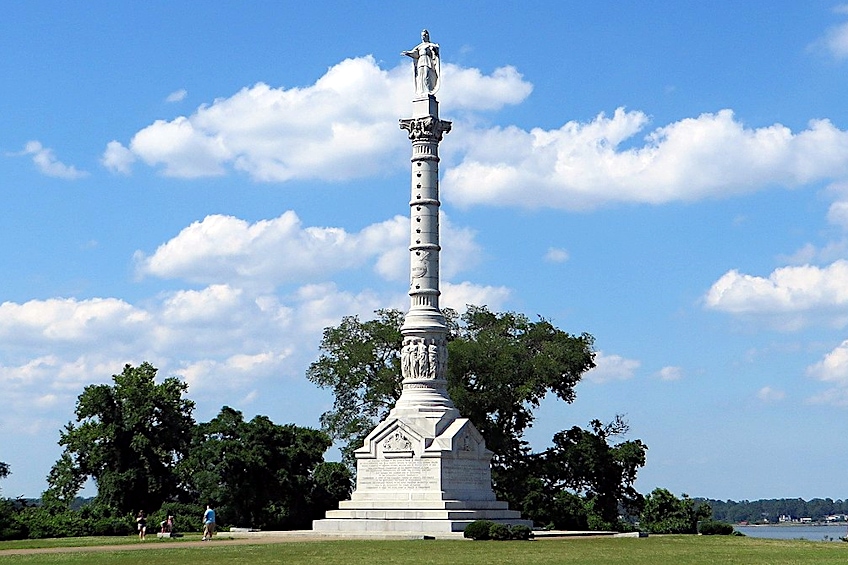 Yorktown Victory Monument; Ken Lund from Reno, Nevada, USA, CC BY-SA 2.0, via Wikimedia Commons
Yorktown Victory Monument; Ken Lund from Reno, Nevada, USA, CC BY-SA 2.0, via Wikimedia Commons
The crowning figure of the memorial was placed on the 12th of August, 1884; it was formally announced as complete on the 5th of January, 1885, and is currently located in Colonial National Historical Park. Mr. J. Q. A. Ward from New York, as well as Mr. Henry Van Brunt from Boston, were among the artists commissioned by the Secretary of War for the memorial project.
Historical Impact and Lessons
An undeniably significant conflict in its time, the Battle of Yorktown provided many lessons to both the victors and those defeated. Many subsequent commanders have taken note of how strategic planning played an important role in winning the battle. The victory at Yorktown was the product of meticulous strategic preparation by the American and French armies. This included using trickery to deceive the British troops, as well as building extensive fortifications to guard against British counterattacks. As a result, the conflict proved the significance of strategic planning in attaining military objectives.
Another lesson learned by those who fought in the Revolutionary War is the value of perseverance. The Revolutionary War was a long and tough war, and the colonial soldiers’ Yorktown victory was the culmination of years of challenging conditions.
As a result, the conflict proved the significance of perseverance in accomplishing long-term goals. The help of French soldiers and naval forces helped ensure the American’s victory at Yorktown. A friendship that France commemorated with their gift to the United States of a monumental statue titled Liberty Enlightening the World, or the Statue of Liberty as it is better known. The war, therefore, also demonstrated the need for international collaboration and alliance formation in accomplishing these kinds of intense military objectives.
 Lithograph depicting Liberty Enlightening the World by Currer and Ives (1885); Currier and Ives, CC0, via Wikimedia Commons
Lithograph depicting Liberty Enlightening the World by Currer and Ives (1885); Currier and Ives, CC0, via Wikimedia Commons
That concludes our article on the facts about the Battle of Yorktown. Without this pivotal moment in the Revolutionary War, the widespread conflict would have perhaps lasted even longer. Thankfully, the colonial troops and their French allies managed to seize the perfect opportunity and caught the English off guard. The American victory at the Battle of Yorktown resulted in the subsequent downfall of the English government and the establishment of a truly independent nation.
Frequently Asked Questions
Who Won the Battle of Yorktown in Virginia?
The united troops of the American colonies, headed by General George Washington, won the battle. The French and American forces landed in Yorktown, where the English had created a formidable defensive position. They then besieged Yorktown, encircling and drilling the British soldiers with artillery fire. After many days of hard battle, the British were compelled to surrender because they were not capable of breaking through the surrounding forces and were running very low on supplies. On the 19th of October, 1781, the surrender was confirmed with a ceremony, and the British men were held captive.
When Was the Battle of Yorktown?
The battle first began on the 28th of September in 1781 and continued until the 19th of October in the same year. In the end, there were around 9,000 casualties in total from both sides of the conflict. Around 7,400 of those comprised of British soldiers that were never found.

I am deeply passionate about history and am constantly fascinated by the rich and complex stories of the past. As the editor-in-chief of learning-history.com, I have the opportunity to share this passion with a wide audience through the creation and distribution of engaging and informative content about historical events, persons, and cultures. Whether it’s through writing articles and blog posts or creating videos or podcasts, I strive to bring the past to life in a way that is both accurate and enjoyable. My expertise in history, combined with my strong writing and communication skills, allows me to effectively communicate complex historical concepts and make them accessible and interesting to a wide range of readers. I am truly grateful for the opportunity to share my love of history with others through my work on learning-history.com.

